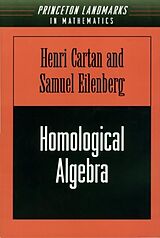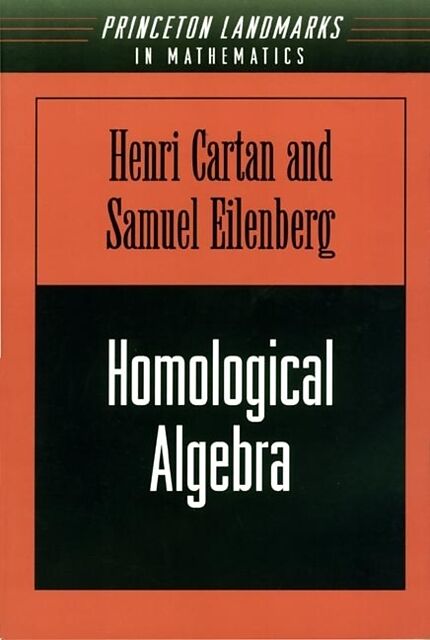Homological Algebra (PMS-19), Volume 19
Einband:
Kartonierter Einband
EAN:
9780691049915
Untertitel:
Englisch
Autor:
Henri Cartan, Samuel Eilenberg
Herausgeber:
Princeton University Press
Anzahl Seiten:
408
Erscheinungsdatum:
19.12.1999
ISBN:
0691049912
Informationen zum Autor Henri Cartan , formerly Professor of Mathematics at the University of Paris, is a Fellow of the Royal Society. Samuel Eilenberg (1914-1998) was Professor of Mathematics at Columbia University. Both were founding members of the Bourbaki and both received the Wolf Prize in Mathematics. Klappentext When this book was written, methods of algebraic topology had caused revolutions in the world of pure algebra. To clarify the advances that had been made, Cartan and Eilenberg tried to unify the fields and to construct the framework of a fully fledged theory. The invasion of algebra had occurred on three fronts through the construction of cohomology theories for groups, Lie algebras, and associative algebras. This book presents a single homology (and also cohomology) theory that embodies all three; a large number of results is thus established in a general framework. Subsequently, each of the three theories is singled out by a suitable specialization, and its specific properties are studied. The starting point is the notion of a module over a ring. The primary operations are the tensor product of two modules and the groups of all homomorphisms of one module into another. From these, "higher order" derived of operations are obtained, which enjoy all the properties usually attributed to homology theories. This leads in a natural way to the study of "functors" and of their "derived functors." This mathematical masterpiece will appeal to all mathematicians working in algebraic topology. Zusammenfassung The invasion of algebra had occurred on three fronts through the construction of cohomology theories for groups, Lie algebras, and associative algebras. This book presents a single homology theory that embodies all three. Inhaltsverzeichnis 10158581
Autorentext
Henri Cartan, formerly Professor of Mathematics at the University of Paris, is a Fellow of the Royal Society. Samuel Eilenberg (1914-1998) was Professor of Mathematics at Columbia University. Both were founding members of the Bourbaki and both received the Wolf Prize in Mathematics.
Klappentext
When this book was written, methods of algebraic topology had caused revolutions in the world of pure algebra. To clarify the advances that had been made, Cartan and Eilenberg tried to unify the fields and to construct the framework of a fully fledged theory. The invasion of algebra had occurred on three fronts through the construction of cohomology theories for groups, Lie algebras, and associative algebras. This book presents a single homology (and also cohomology) theory that embodies all three; a large number of results is thus established in a general framework. Subsequently, each of the three theories is singled out by a suitable specialization, and its specific properties are studied. The starting point is the notion of a module over a ring. The primary operations are the tensor product of two modules and the groups of all homomorphisms of one module into another. From these, "higher order" derived of operations are obtained, which enjoy all the properties usually attributed to homology theories. This leads in a natural way to the study of "functors" and of their "derived functors." This mathematical masterpiece will appeal to all mathematicians working in algebraic topology.
Zusammenfassung
The invasion of algebra had occurred on three fronts through the construction of cohomology theories for groups, Lie algebras, and associative algebras. This book presents a single homology theory that embodies all three.
Inhalt
Preface v
Chapter I. Rings and Modules 3
1. Preliminaries 3
2. Projective modules 6
3. Injective modules 8
4. Semi-simple rings 11
5. Hereditary rings 12
6. Semi-hereditary rings 14
7. Noetherian rings 15
Exercises 16
Chapter II. Additive Functors 18
1. Definitions 18
2. Examples 20
3. Operators 22
4. Preservation of exactness 23
5. Composite functors 27
6. Change of rings 28
Exercises 31
Chapter III. Satellites 33
1. Definition of satellites 33
2. Connecting homomorphisms 37
3. Half exact functors 39
4. Connected sequence of functors 43
5. Axiomatic description of satellites 45
6. Composite functors 48
7. Several variables 49
Exercises 51
Chapter IV. Homology 53
1. Modules with differentiation 53
2. The ring of dual numbers 56
3. Graded modules, complexes 58
4. Double gradings and complexes 60
5. Functors of complexes 62
6. The homomorphism x 64
7. The homomorphism x (continuation) 66
8. Kunneth relations 71
Exercises 72
Chapter V. Derived Functors 75
1.Complexes over modules; resolutions 75
2.Resolutions of sequences 78
3.Definition of derived functors 82
4.Connecting homomorphisms 84
5.The functors ROT and LOT 89
6.Comparison with satellites 90
7.Computational devices 91
8.Partial derived functors 94
9.Sums, products, limits 97
10.The sequence of a map 101
Exercises 104
Chapter VI. Derived Functors of 0 and Hom 106
1. The functors Tor and Ext 106
2. Dimension of modules and rings 109
3. Kunneth relations 112
4. Change of rings 116
5. Duality homomorphisms 119
Exercises 122
Chapter VII. Integral Domains 127
1. Generalities 127
2. The field of quotients 129
3. Inversible ideals 132
4. Prufer rings 133
5. Dedekind rings 134
6. Abelian groups 135
7. A description of Tor1, (A,C) 137
Exercises 139
Chapter VIII. Augmented Rings 143
1. Homology and cohomology of an augmented ring 143
2. Examples 146
3. Change of rings 149
4. Dimension 150
5. Faithful systems 154
6. Applications to graded and local rings 156
Exercises 158
Chapter IX. Associative Algebras 162
1. Algebras and their tensor products 162
2. Associativity formulae 165
3. The enveloping algebra Ae 167
4. Homology and cohomology of algebras 169
5. The Hochschild groups as functors of A 171
6. Standard complexes 174
7. Dimension 176
Exercises 180
Chapter X. Supplemented Algebras 182
1. Homology of supplemented algebras 182
2. Comparison with Hochschild groups 185
3. Augmented monoids 187
4. Groups 189
5. Examples of resolutions 192
6. The inverse process193
7. Subalgebras and subgroups 196
8. Weakly injective and projective modules 197
Exercises 201
Chapter XI. Products 202
1. External products 202
2. Formal properties of the products 206
3. Isomorphisms 209
4. Internal products 211
5. Computation of products
6. Products in the Hochschild theory 216
7. Products for supplemented algebras 219
8. Associativity formulae 222
9. Reduction theorems 225
Exercises 228
Chapter XII. Finite Groups 232
1. Norms 232
2. The complete derived sequence 235
3. Complete resolutions 237
4. Products for finite groups 242
5. The uniqueness theorem 244
6. Duality 247
7. Examples 250
8. Relations with subgroups 254
9. Double cosets 256
10 p-groups and Sylow groups 258
11. Periodicity 260
Exercises 263
Chapter XIII. Lie Algebras 266
1. Lie algebras and their enveloping algebras 266
2. Homology and cohomology of Lie algebras 270
3. The Poincare-Witt theorem 271
4. Subalgebras and ideals 274
5. The diagonal map and its applications 275
6. A relation in the standard complex 277
7. The complex V(g) 279
8. Applications of the complex V(g) 282
Exercises 284
Chapter XIV. Extensions 289
1. Extensions

Leider konnten wir für diesen Artikel keine Preise ermitteln ...
billigbuch.ch sucht jetzt für Sie die besten Angebote ...
Die aktuellen Verkaufspreise von 6 Onlineshops werden in Realtime abgefragt.
Sie können das gewünschte Produkt anschliessend direkt beim Anbieter Ihrer Wahl bestellen.
Loading...
Die aktuellen Verkaufspreise von 6 Onlineshops werden in Realtime abgefragt.
Sie können das gewünschte Produkt anschliessend direkt beim Anbieter Ihrer Wahl bestellen.
| # | Onlineshop | Preis CHF | Versand CHF | Total CHF | ||
|---|---|---|---|---|---|---|
| 1 | Seller | 0.00 | 0.00 | 0.00 |
